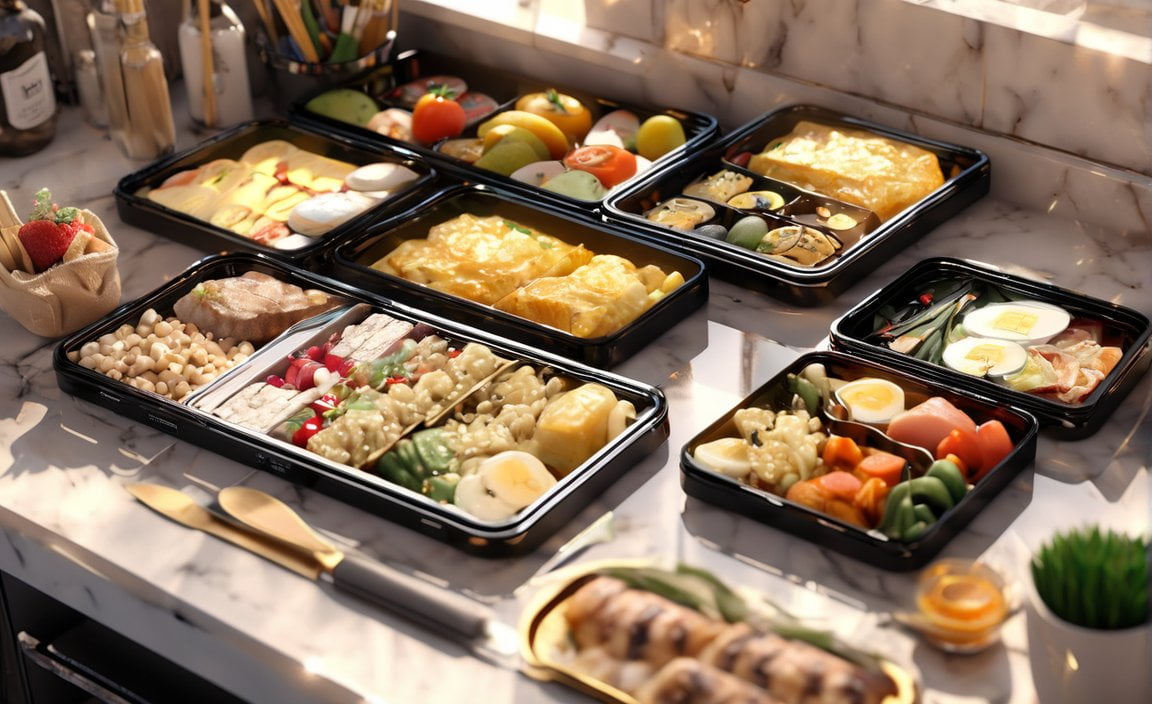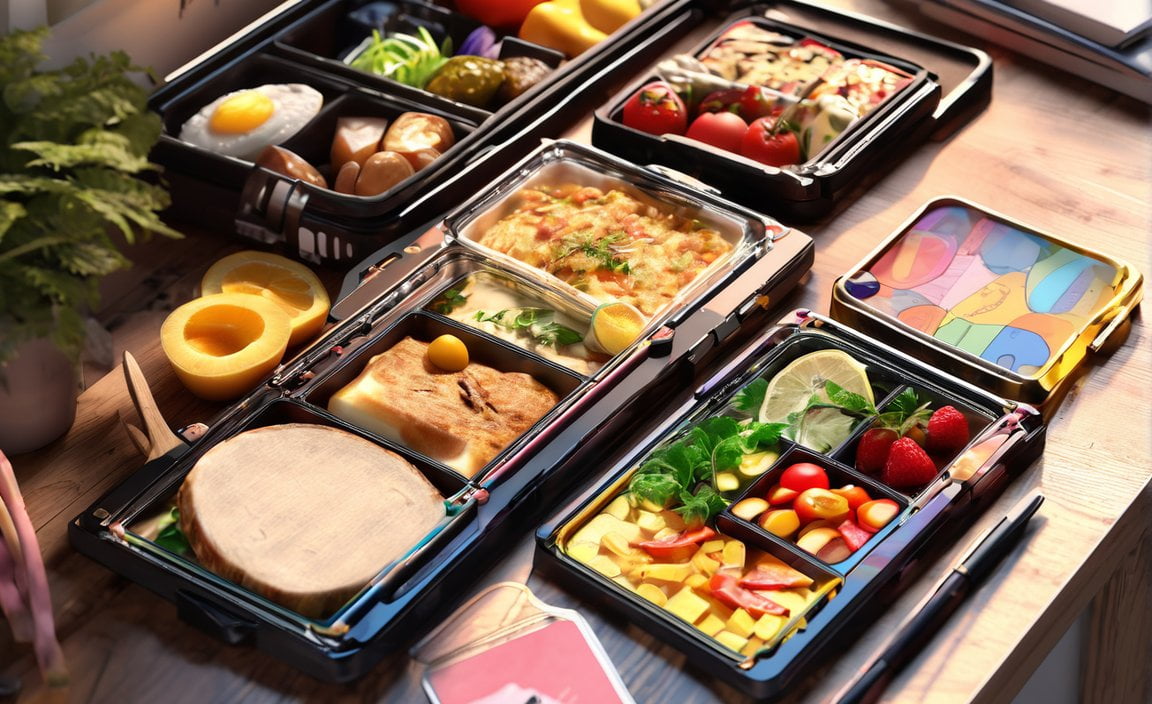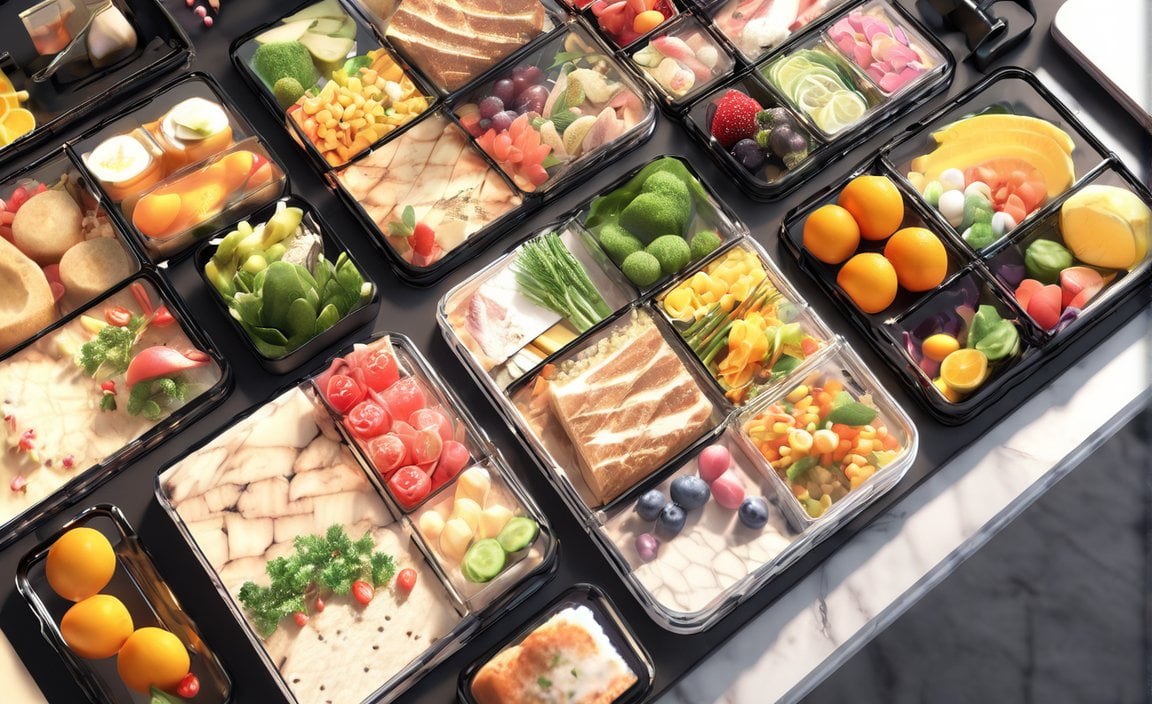Optimize Your Nutrition with a 5 Meals-a-Day Planner. Are you looking to take your nutrition to the next level? Look no further than a 5 meals-a-day planner, a tool that can revolutionize the way you eat. This planner provides a structured approach to incorporating five meals into your daily routine, ensuring that you are nourishing your body with the right nutrients throughout the day. Whether you have specific dietary requirements or simply want to enhance your overall well-being, a 5 meals-a-day planner can be the key to unlocking your full nutritional potential. Get ready to embark on a journey towards a healthier lifestyle with our expert guidance and meal planning expertise.
Key Takeaways:
- Incorporating a 5 meals-a-day planner can optimize your nutrition and help you achieve a healthier lifestyle.
- The Speedy Huevos Rancheros recipe makes for a quick and savory breakfast option packed with protein and fiber.
- Quick Rice & Bean Burritos are a convenient lunch choice, perfect for those on-the-go.
- For a satisfying and easy-to-make dinner, try the Quick and Easy Vegetarian Black Bean Soup recipe.
- Leftovers can be transformed into a delicious meal with the Quick Chicken Fried Rice recipe.
- GoodTo and WebMD are helpful sources for finding more 5-a-day meal plans and information on the benefits of the five-meal plan for health and fitness.
5 Meals-a-Day Planner

In today’s fast-paced world, it can be challenging to prioritize our nutrition and make conscious choices about what we eat. However, with the right meal planning and a dedicated commitment to our health, it is possible to optimize our nutrition and achieve a healthier lifestyle. One effective and highly beneficial approach to meal planning is the 5 meals-a-day planner. In this instructional guide, we will explore the benefits of this approach and provide you with delicious recipes to get started.
Why Choose a 5 Meals-a-Day Planner?
The 5 meals-a-day planner offers several advantages for individuals looking to optimize their nutrition. By dividing your daily food intake into five smaller meals, you can:
Regulate portion sizes: With smaller meals spread throughout the day, you have better control over portion sizes, which can help prevent overeating and promote weight management.
Maintain steady energy levels: By fueling your body with regular meals, you can avoid energy crashes and keep your energy levels stable throughout the day. This can help improve concentration, productivity, and overall well-being.
Support metabolism: Eating smaller, frequent meals can help boost your metabolism by keeping it active throughout the day. This can aid in digestion, nutrient absorption, and calorie burning.
Control cravings: By providing your body with regular nourishment, the 5 meals-a-day planner can help curb cravings and reduce the likelihood of reaching for unhealthy snacks or indulging in high-calorie foods.
Promote balanced nutrition: With five meals to plan, you have the opportunity to incorporate a variety of nutrient-dense foods, ensuring a well-rounded and balanced diet. This approach makes it easier to meet your daily requirements for essential vitamins, minerals, fiber, and macronutrients.
Now that you understand the benefits of a 5 meals-a-day planner, let’s dive into some tasty recipe ideas to kickstart your meal planning journey.
Breakfast: Speedy Huevos Rancheros
Start your day with a protein-packed and fiber-rich breakfast like Speedy Huevos Rancheros. This quick and savory dish is sure to satisfy your taste buds and keep you feeling full until lunchtime. Here’s how you can prepare it:
Ingredients:
– 2 large eggs
– 2 corn tortillas
– 1/2 cup black beans, rinsed and drained
– 1/4 cup diced tomatoes
– 1/4 cup chopped onions
– 1/4 cup shredded cheddar cheese
– Hot sauce (optional)
– Salt and pepper to taste
Instructions:
1. Heat a non-stick skillet over medium heat and lightly coat it with cooking spray.
2. In a separate bowl, beat the eggs and season with salt and pepper.
3. Place the tortillas in the skillet and heat for about 1 minute on each side until warmed through. Remove from the skillet and set aside.
4. In the same skillet, sauté the onions until they become translucent. Add the black beans and diced tomatoes, and cook for another 2-3 minutes.
5. Push the bean mixture to one side of the skillet and pour the beaten eggs into the other side. Scramble the eggs until cooked to your preference.
6. To assemble, place a tortilla on a plate and spoon half of the bean mixture onto it. Top with half of the scrambled eggs and sprinkle with shredded cheese. Repeat for the second tortilla.
7. Serve with hot sauce on the side, if desired. Enjoy your nutritious and satisfying breakfast!
Lunch: Quick Rice & Bean Burritos
For a convenient on-the-go lunch option that combines protein, fiber, and whole grains, try Quick Rice & Bean Burritos. These tasty burritos are easy to prepare and provide a satisfying meal that will keep you fueled throughout the day. Here’s how to make them:
Ingredients:
– 2 whole wheat tortillas
– 1 cup cooked brown rice
– 1 cup black beans, rinsed and drained
– 1/4 cup diced bell peppers
– 1/4 cup diced onions
– 1/4 cup chopped fresh cilantro
– 2 tablespoons salsa
– 2 tablespoons low-fat sour cream (optional)
– Salt and pepper to taste
Instructions:
1. In a mixing bowl, combine the cooked brown rice, black beans, bell peppers, onions, cilantro, salsa, salt, and pepper. Mix well to ensure the ingredients are evenly distributed.
2. Warm the tortillas in a dry skillet over medium heat for about 1 minute on each side.
3. Divide the rice and bean mixture equally between the two tortillas, placing it in the center.
4. Fold the sides of the tortillas towards the center, then roll them up tightly to create burritos.
5. If desired, warm the burritos in a skillet or microwave for a few seconds to heat through.
6. Serve with a dollop of low-fat sour cream, if desired. Enjoy your flavorful and nutritious lunch on the go!
Dinner: Quick and Easy Vegetarian Black Bean Soup
As the day winds down, treat yourself to a warm and comforting bowl of Quick and Easy Vegetarian Black Bean Soup. This wholesome soup is packed with protein, fiber, and an array of flavors that will leave you feeling satisfied and nourished. Here’s the recipe:
Ingredients:
– 1 can (15 ounces) black beans, rinsed and drained
– 1 cup diced tomatoes
– 1/2 cup diced onions
– 1/4 cup diced bell peppers
– 2 cloves garlic, minced
– 2 cups vegetable broth
– 1 teaspoon cumin
– 1/2 teaspoon chili powder
– Salt and pepper to taste
– Fresh lime wedges for serving
– Fresh cilantro for garnish
Instructions:
1. In a large pot, sauté the onions, bell peppers, and garlic until they become fragrant and slightly softened.
2. Add the black beans, diced tomatoes, vegetable broth, cumin, chili powder, salt, and pepper to the pot. Stir well to combine.
3. Bring the mixture to a boil, then reduce the heat and simmer for about 10-15 minutes to allow the flavors to meld together.
4. Using an immersion blender or a regular blender, blend the soup until smooth and creamy. If using a regular blender, return the soup to the pot after blending.
5. Adjust the seasoning if needed, and heat the soup for another 2-3 minutes.
6. Ladle the soup into bowls and garnish with fresh cilantro. Squeeze a wedge of lime over each serving for an extra burst of flavor. Enjoy your nourishing and delicious dinner!
Dinner: Quick Chicken Fried Rice
If you have some leftover chicken and cooked rice on hand, turn them into a delightful meal with Quick Chicken Fried Rice. This recipe is a great way to use up leftovers while still enjoying a delicious and nutritious dinner. Here’s how to prepare it:
Ingredients:
– 2 cups cooked brown rice
– 1 cup cooked chicken breast, diced
– 1/2 cup diced carrots
– 1/2 cup frozen peas
– 1/4 cup diced onions
– 2 cloves garlic, minced
– 2 tablespoons low-sodium soy sauce
– 1 tablespoon sesame oil
– 2 eggs, beaten
– Salt and pepper to taste
– Green onions for garnish (optional)
Instructions:
1. In a large skillet or wok, heat the sesame oil over medium-high heat.
2. Add the onions, carrots, and garlic to the skillet and stir-fry for about 2-3 minutes until the vegetables start to soften.
3. Push the vegetables to one side of the skillet and pour the beaten eggs into the other side. Scramble the eggs until fully cooked, then mix them with the vegetables.
4. Add the cooked brown rice and diced chicken to the skillet, stirring constantly to combine all the ingredients.
5. Drizzle the low-sodium soy sauce over the rice mixture, and continue to cook for another 2-3 minutes.
6. Stir in the frozen peas and cook for an additional minute until they are heated through.
7. Season with salt and pepper according to your taste.
8. Garnish with chopped green onions, if desired. Enjoy a flavorful and satisfying dinner using your leftovers!
With these delicious recipes, you can start incorporating a 5 meals-a-day planner into your routine and optimize your nutrition easily. Remember to make conscious choices about the ingredients you use, considering your dietary requirements and personal preferences. Happy meal planning and bon appétit!
References:
[^1^] Recipes adapted from GoodTo: 5-a-day meal plans.
[^2^] GoodTo: 5-a-day meal plans.
[^3^] WebMD: The Five-Meal Plan for Health and Fitness.
If you’re fascinated by light energy, you’ll be amazed by these 5 facts! Explore more about it here.
Water is considered an essential element in Sanskrit. Discover 5 lines on the importance of water in Sanskrit here.
Are you looking for reasons to get a furry companion? Learn about the 5 convincing reasons to get a dog here.
Trees hold extraordinary wonders! Uncover 5 amazing facts about trees here.
Creating a Flexible Menu for Your 5 Meals-a-Day Planner

Meal planning can be a game-changer when it comes to maintaining a healthy, well-balanced diet. With a well-crafted 5 meals-a-day planner, you can optimize your nutrition, save time, and stay on track with your health goals. In this article, we’ll explore how to create a flexible menu for your 5 meals-a-day planner, taking into consideration your dietary preferences and personal needs.
Key Takeaways:
- Meal planning with a 5 meals-a-day planner can help optimize nutrition and save time.
- Variety is key when creating a flexible menu for your 5 meals-a-day planner.
- Incorporate different food groups and aim for balanced meals throughout the day.
- Consider your dietary preferences, such as vegetarian, gluten-free, or low-carb options.
- Choose recipes that are easy to prepare and store well for multiple meals.
Now, let’s dive into the steps you can follow to create a flexible menu for your 5 meals-a-day planner:
Step 1: Determine Your Goals and Preferences
Before starting your meal planning journey, it’s important to identify your goals and dietary preferences. Are you looking to lose weight, gain muscle, or simply eat healthier? Understanding your objectives will guide your menu choices. Additionally, consider any dietary restrictions or preferences you have, such as being vegetarian, vegan, or following a specific dietary approach like the Mediterranean or keto diet.
Step 2: Plan Your Meals Around Food Groups
To ensure a well-balanced and nutritious menu, it’s essential to include a variety of food groups in your 5 meals-a-day plan. Aim to incorporate:
– Lean proteins like chicken, fish, tofu, or legumes.
– Whole grains such as quinoa, brown rice, or whole wheat pasta.
– Colorful fruits and vegetables for essential vitamins, minerals, and fiber.
– Healthy fats like avocado, nuts, seeds, or olive oil.
By including a variety of food groups, you’ll provide your body with a wide range of nutrients, keeping your meals interesting and your taste buds satisfied.
Step 3: Create a Meal Plan Template
Having a meal plan template can make the meal planning process more organized and efficient. Fortunately, there are many customizable templates available online, such as those provided by Canva. These templates allow you to personalize your meal plan based on your specific needs and preferences. Utilize the [Creating a flexible menu for your 5 meals-a-day planner] template from Canva to design your ideal meal plan.
Step 4: Mix and Match Recipes
Creating a flexible menu involves mixing and matching recipes that align with your goals and preferences. Look for recipes that are nutritious, easy to prepare, and can be stored well for multiple meals. This will not only save you time but also prevent food waste.
GoodTo offers fantastic 5-a-day meal plans with various recipe ideas. Use their recipes as inspiration and adapt them to suit your tastes and dietary requirements. By incorporating different recipes throughout the week, you’ll keep your menu exciting and prevent mealtime boredom.
Step 5: Prepare a Grocery List
Once you have your meal plan in place, it’s time to create a grocery list. Go through each recipe and note down the ingredients you’ll need. Having a well-organized grocery list will streamline your shopping experience and ensure you have everything you need for your meals.
Step 6: Stay Flexible
One of the key benefits of creating a flexible menu is the ability to adapt and make changes as needed. Life can get busy, and unexpected events may arise, so it’s essential to have a backup plan. Keep your pantry stocked with versatile ingredients that can be used in a variety of dishes. This way, if a last-minute change occurs, you’ll still have options readily available.
Key Takeaways:
- Meal planning with a 5 meals-a-day planner can help optimize nutrition and save time.
- Variety is key when creating a flexible menu for your 5 meals-a-day planner.
- Incorporate different food groups and aim for balanced meals throughout the day.
- Consider your dietary preferences, such as vegetarian, gluten-free, or low-carb options.
- Choose recipes that are easy to prepare and store well for multiple meals.
Sources:
1. Canva. “Free, customizable meal planner menu templates | Canva.” Retrieved from link
2. GoodTo. “5-a-day meal plans.” Retrieved from link
Incorporating Variety and Diversity in Your Meal Choices
Eating a variety of foods is not only important for our health but also adds excitement and enjoyment to our meals. Incorporating variety and diversity in your meal choices can ensure that you receive a wide range of nutrients and flavors. In this guide, we will explore the benefits of food variety, provide practical tips for incorporating variety into your meals, and discuss the impact of variety within and across meals.
Why Is Food Variety Important?
Adding variety to your meals offers numerous benefits for your overall health and well-being. Variety can:
- Ensure that you receive a wide range of essential nutrients, as different foods contain different vitamins, minerals, and antioxidants.
- Help prevent nutrient deficiencies by diversifying your food choices.
- Make meals more enjoyable and prevent monotony in your eating routine.
- Enhance your culinary skills and expose you to new flavors, textures, and cooking methods.
- Improve your appetite regulation by stimulating different taste receptors and preventing food fatigue.
- Encourage a more balanced and nutritious diet by including a variety of food groups.
Tips for Incorporating Variety in Your Meals
Now that we understand the importance of food variety, let’s explore some practical tips for incorporating variety and diversity in your meal choices:
Experiment with Spices and Herbs: Instead of relying on sugary sauces and dressings, experiment with an array of spices and herbs to enhance the flavors of your meals without adding unnecessary calories. From turmeric to paprika, cinnamon to basil, there are countless options to add depth and richness to your dishes.
Make Fruits and Vegetables the Star: When planning your meals, make a conscious effort to include a colorful array of fruits and vegetables. These nutrient-dense foods offer a wide range of vitamins, minerals, and phytochemicals. They can be incorporated into breakfast smoothies, salads, soups, stir-fries, and snacks.
Diversify Your Protein Sources: Whether you’re a vegetarian or a meat lover, diversifying your protein sources can provide a wider range of essential amino acids. Consider incorporating plant-based proteins like legumes, tofu, and tempeh, alongside lean meats, poultry, fish, and dairy products.
Explore International Cuisines: Embrace the flavors of different cultures by exploring international cuisines. Mexican, Indian, Thai, Mediterranean, and Japanese cuisines, among others, offer a vast array of ingredients, spices, and cooking techniques that can introduce new flavors and enhance your dining experiences.
Focus on Different Textures: Incorporate foods with varying textures into your meals to add interest and enjoyment. Think crunchy salads, creamy soups, chewy whole grains, and smooth purees. Experimenting with textures can elevate your eating experience and make your meals more satisfying.
Plan your Meals: Meal planning is a powerful tool to ensure a diverse and well-balanced diet. By intentionally selecting a variety of foods and recipes, you can avoid falling into a rut and ensure that you are receiving optimal nutrition. Consider using meal planner templates or mobile apps to streamline the process and make it easier to stick to your plan.
Mix and Match: Don’t be afraid to mix and match ingredients to create unique flavor combinations. For example, try pairing sweet fruits with savory salads or adding nuts and seeds for extra crunch. Experimenting with different combinations can add excitement to your meals and expand your culinary horizons.
Embrace Seasonal Produce: Eating seasonal produce not only supports local farmers but also ensures that you are enjoying fruits and vegetables at their peak flavor and nutritional value. Visit your local farmer’s market or join a Community Supported Agriculture (CSA) program to access a variety of fresh, seasonal produce.
Key Takeaways:
- Incorporating variety and diversity in your meal choices is essential for optimal nutrition and enjoyment.
- Experiment with spices and herbs to enhance flavors without relying on sugary sauces.
- Make fruits and vegetables the star of your meals to boost nutrient intake and add color to your plate.
- Diversify your protein sources by including both plant-based and animal-based proteins.
- Explore international cuisines to experience new flavors and cooking techniques.
- Focus on different textures to elevate your eating experience.
- Plan your meals using templates or mobile apps to ensure diversity and balance.
- Mix and match ingredients to create unique flavor combinations.
- Embrace seasonal produce for freshness and optimal flavor.
Sources:
1. MealPrep – “How to Incorporate Variety into Your Meals”
2. The Conversation – “Food Variety is Important for Our Health”
Tips for Successful Implementation and Adherence to a 5 Meals-A-Day Planner
Are you considering adopting a 5 meals-a-day planner for better nutrition and weight management? This article provides valuable tips to help you successfully implement and adhere to this eating pattern. From meal planning to portion control, these practical strategies will guide you on your journey towards a healthier lifestyle.
1. Make a Meal Plan
Creating a meal plan is essential for successfully following a 5 meals-a-day planner. By planning your meals in advance, you can ensure that you have healthy options available throughout the day. Consider your dietary preferences, nutritional needs, and portion sizes while designing your meal plan. This will help you stay on track and avoid unhealthy food choices.
2. Prepare Meals in Advance
To make your 5 meals-a-day plan even more convenient, prepare your meals in advance. Spend some time each week cooking and portioning your meals into containers. This way, you’ll have nutritious options readily available when hunger strikes. Prep healthy snacks too, so you’re always armed with wholesome choices to keep you satisfied between meals.
3. Opt for Smaller Portions
One of the pillars of a 5 meals-a-day plan is consuming smaller portions. This approach allows for better regulation of calorie intake and can support weight loss efforts. Focus on incorporating lean proteins, whole grains, fruits, and vegetables into your meals and snacks. These nutrient-dense foods will keep you feeling full and satisfied while providing essential vitamins and minerals.
4. Prioritize Nutrient-Dense Foods
When following a 5 meals-a-day plan, it’s crucial to prioritize nutrient-dense foods. These foods are rich in essential nutrients while being relatively low in calories. Including a variety of fruits, vegetables, whole grains, lean proteins, and healthy fats in your meals will help you meet your nutritional needs and promote overall wellness.
5. Stay Hydrated
Proper hydration is vital for optimal health and plays a significant role in weight management. Make sure to drink plenty of water throughout the day to stay hydrated and support your body’s functions. Water can also help you feel full, reducing the temptation to snack unnecessarily between meals.
6. Listen to Your Body
Paying attention to your body’s hunger and fullness cues is key to successful adherence to a 5 meals-a-day plan. Eat until you are satisfied, but not overly full. Avoid mindless snacking and be mindful of your eating habits. Recognize when you’re eating out of boredom or emotions, and find alternative ways to cope with those feelings.
7. Stick to Regular Meal Times
To maintain a steady metabolism and promote consistent energy levels, it’s essential to eat your meals at regular intervals. Aim to eat every three hours, following the pattern of breakfast, mid-morning snack, lunch, mid-afternoon snack, and dinner. By establishing a routine, you’ll avoid extreme hunger or overeating, ensuring better portion control and nutrient distribution throughout the day.
8. Practice Mindful Eating
Practice mindful eating as a tool for successful implementation of a 5 meals-a-day plan. Be present while you eat, savoring each bite and paying attention to the flavors and textures. By slowing down and fully enjoying your meals, you’ll be more satisfied and less likely to overeat. Mindful eating also helps you foster a positive relationship with food and cultivates a deeper awareness of your body’s needs.
9. Address Emotional Eating
Emotional eating can derail any meal plan, including a 5 meals-a-day planner. It’s important to address the underlying causes of emotional eating, such as stress, boredom, or sadness. Seek alternative coping mechanisms like exercise, journaling, or talking to a supportive friend. By addressing emotional eating, you’ll be better equipped to sustain your adherence to a well-structured eating plan.
10. Seek Professional Guidance
For personalized guidance and support, consider consulting a registered nutritionist or dietitian. These professionals have the expertise to assess your individual needs and create a tailored 5 meals-a-day plan that aligns with your goals and dietary requirements. They can also provide ongoing accountability to help you stay motivated and achieve lasting success.
Now that you have learned valuable tips for successful implementation and adherence to a 5 meals-a-day planner, you are well-equipped to optimize your nutrition and achieve your health and wellness goals. By following these guidelines and incorporating them into your daily routine, you’ll be on your way to a healthier, more balanced lifestyle.
Key Takeaways:
- Create a meal plan that aligns with your dietary needs and preferences.
- Prepare your meals in advance to ensure healthy options are readily available.
- Opt for smaller portion sizes and focus on nutrient-dense foods.
- Stay hydrated by drinking plenty of water throughout the day.
- Listen to your body’s hunger and fullness cues and eat mindfully.
- Stick to regular meal times for maintaining a steady metabolism.
- Address emotional eating and seek alternative coping mechanisms.
- Consider consulting a registered nutritionist or dietitian for personalized guidance.
Sources:
- BetterMe. 5 Meals A Day: Can Smaller Portions Boost Your Weight Loss?
- National Center for Biotechnology Information. Effect of ‘Almost 5 Meal Diet Plan’ on Weight Loss and Body Composition
FAQ
Q1: What is a 5 meals-a-day planner?
A1: A 5 meals-a-day planner is a meal planning approach that involves consuming five small meals throughout the day. It typically includes breakfast, a mid-morning snack, lunch, a mid-afternoon snack, and dinner.
Q2: How can a 5 meals-a-day planner help with weight loss?
A2: A 5 meals-a-day planner can help with weight loss by maintaining a steady metabolism and preventing overeating. By eating smaller portion sizes more frequently, it can help control hunger and stabilize blood sugar levels, leading to better portion control and reduced calorie intake.
Q3: Can a 5 meals-a-day planner cater to different dietary requirements?
A3: Yes, a 5 meals-a-day planner can be customized to cater to different dietary requirements. Whether you follow a vegetarian, gluten-free, or low-carb diet, the meals can be adjusted accordingly to meet your specific needs.
Q4: How do I get started with a 5 meals-a-day planner?
A4: To get started with a 5 meals-a-day planner, it is helpful to make a meal plan and prepare your meals in advance. Focus on incorporating lean proteins, whole grains, fruits, and vegetables into your meals and snacks. Prioritize nutrient-dense foods and be mindful of portion sizes.
Q5: Can a 5 meals-a-day planner be beneficial for long-term health and nutrition?
A5: Yes, a 5 meals-a-day planner can be beneficial for long-term health and nutrition. It promotes balanced eating, portion control, and provides consistent fuel throughout the day. It can help regulate blood sugar levels, improve digestion, and support overall well-being when combined with a nutrient-rich diet.
















